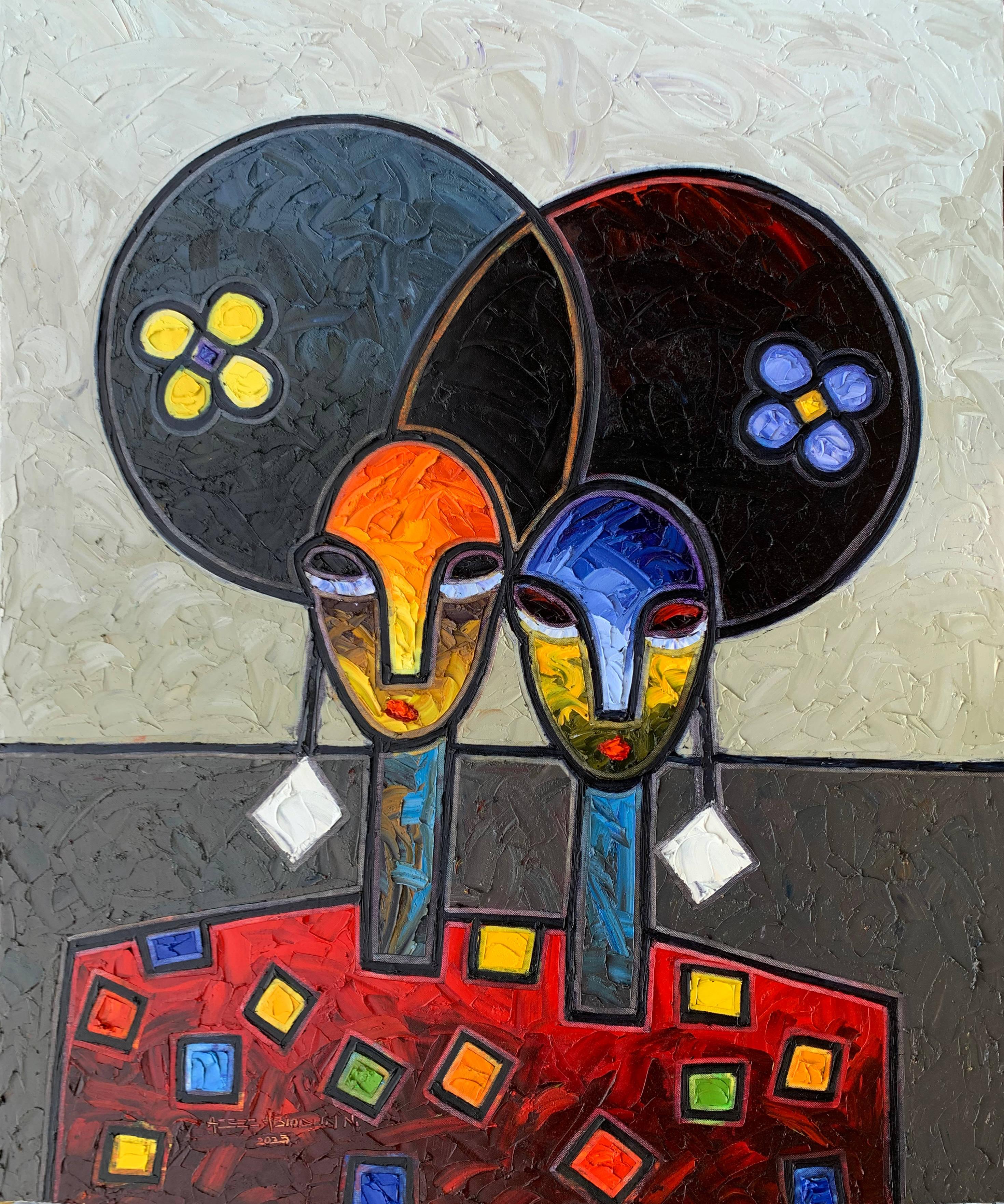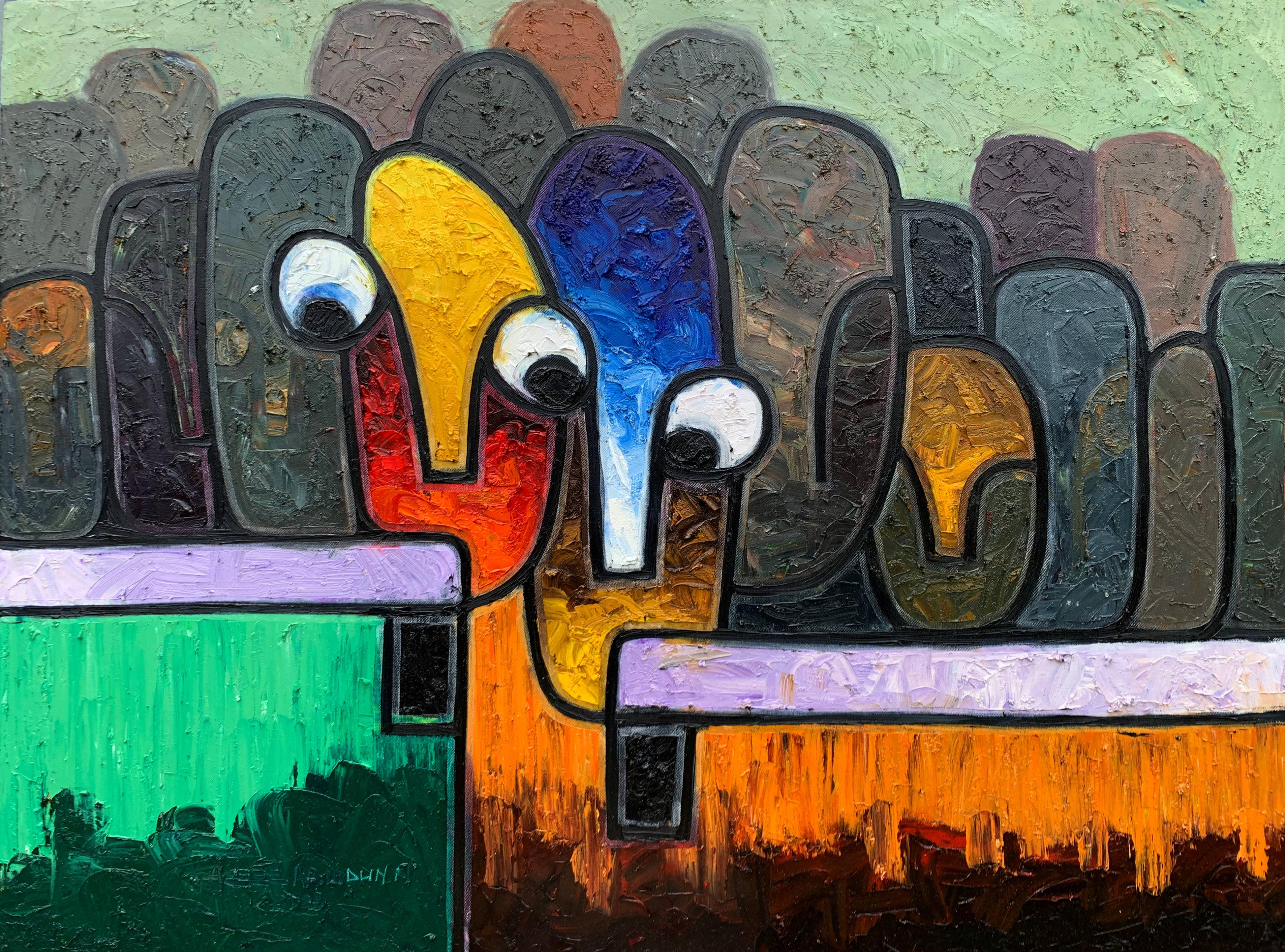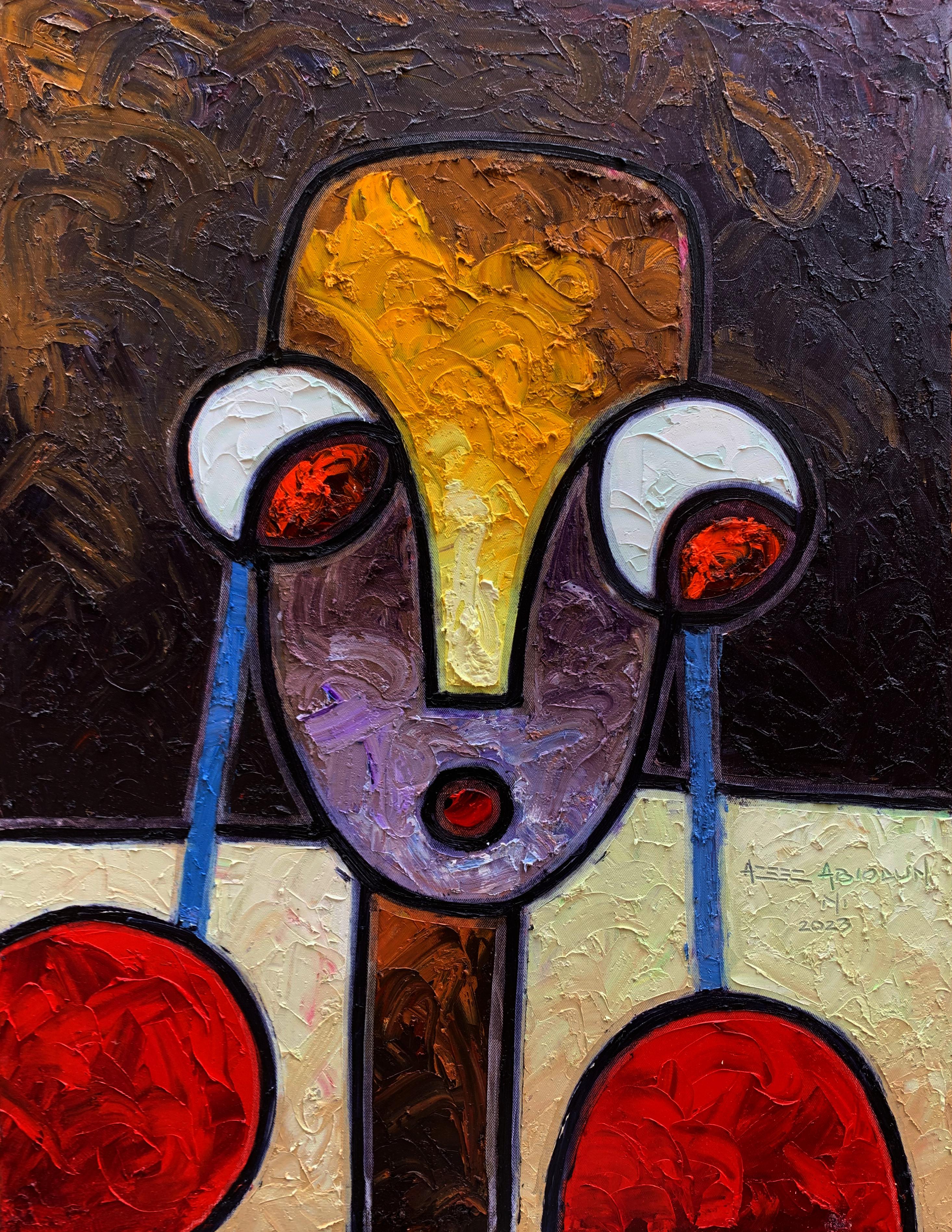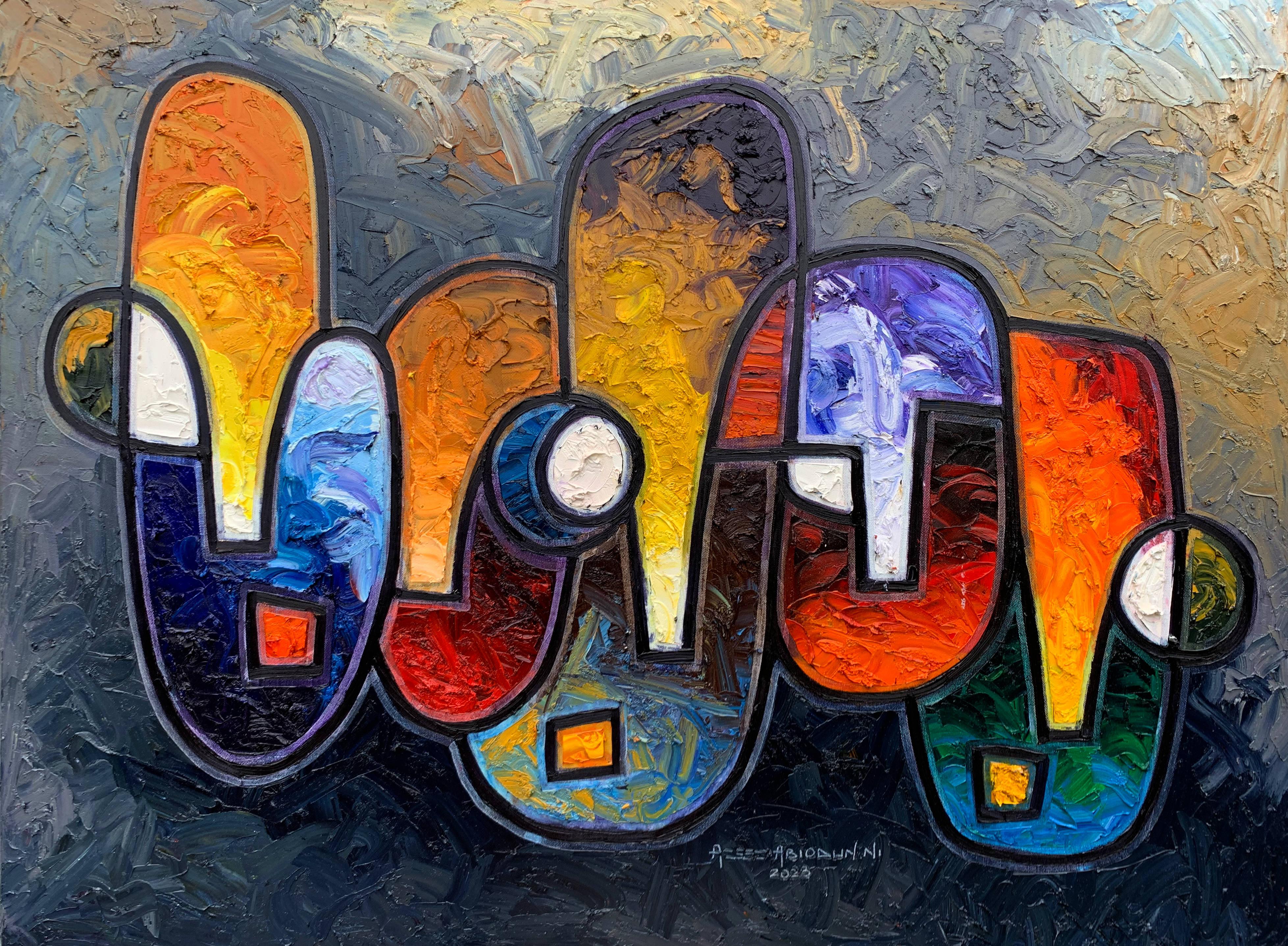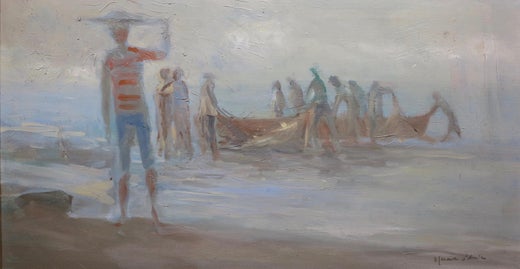Oskar D'AmicoFisherman at Duskc.1960
c.1960
About the Item
- Creator:Oskar D'Amico (1923 - 2003, Italian)
- Creation Year:c.1960
- Dimensions:Height: 16 in (40.64 cm)Width: 30 in (76.2 cm)Depth: 1 in (2.54 cm)
- Medium:
- Movement & Style:
- Period:
- Condition:
- Gallery Location:Wilton Manors, FL
- Reference Number:1stDibs: LU24523581842
Oskar D'Amico
Oskar Maria D'Amico was an active Italian artist in Rome, Naples, Lanciano, Cisterna, Milan, Gallarate, Torino, Zagabria, Paris, Toulouse, Melun, Carenac, Maubeuge, Madrid, Barcelona, Zaragoza, Budapest, Győr, Mexico City, Cuernavaca, Morelia, Toronto, New York City, Philadelphia, Los Angeles, San Francisco, Miami, Denver, Santa Fe, Albuquerque and Socorro, between 1943 and 2003. He is considered a Nomad artist because of his ability to work in various styles. He had three major periods in his artistic life, Figurative, Materic and Geometric. He also was an outstanding art director for more than 75 epic movies. D'Amico had a very outgoing personality. He was a non-conformist, which was reflected in his work throughout his life. D'Amico was born in Castel Frentano, Italy, a small village in Abruzzo. At a young age, he felt he had to leave and dive into the big world. After being a seminarist with the Salesiani during World War II, he left Naples, where he studied architecture and began a great adventure in Rome. He specialized at the time in decorating nightclubs and bars and invented a special type of double ceiling to hide the lights. D'Amico, who was self-taught as a teenager in drawing and painting, burst onto the filmmaking scene in Rome when an art director asked him to do a perspective of set design. Soon other movie makers were calling him.
D'Amico was an art director for 75 films including two by Orson Welles. D’Amico was able to create a real marble floor in the palace of King Saul, in David and Goliath directed by Orson Welles. Art directors previously painted a simulated marble on top of concrete due to the cost of the real thing. D'Amico became an associate of Jadran Films in ex-Yugoslavia, which specialized in Roman and Egyptian constructions. While an art director, he never stopped painting. His faceless clowns, reflecting the people who had no identity after World War II, were a big success. In the early 1960s, D'Amico moved with his family to Toronto, Canada, another place he felt that was too small. He left for Philadelphia and New York City, which affected his work. He turned his focus to abstract and for more than a decade, created abstract Expressionist paintings on the plane of all matter that he called Materic. The Materic style, which he invented, was done in several media and could not be changed once on the canvas. The paintings were very well received. D’Amico sold more than 400 in Philadelphia and New York City. Unfortunately, he had to stop doing the Materics, because the colors he used were harmful to his liver. In the mid-1970s, he returned to his architectural roots and developed a new vision for Abstract Constructivism using just acrylic colors. Presented in Paris by his French Art dealer, Francoise Tournier, at the Grand Palais de Paris and in Mexico City, D'Amico's interpretation of the "New Geometry" was widely admired. In 1983, when he presented the work at the Bodley Gallery, people whispered that he had the potential to be the new Picasso because of his eclecticism and the Nomad nature of his styles. In 1987, D'Amico abandoned the gypsy life and settled in New Mexico. Albuquerque was the perfect place to dedicate himself 100 percent to his work.
There were no distractions and a good climate that reminded him of his beloved Cuernavaca in Mexico. Staying in close contact with his French art dealer Tournier, D’Amico had several shows in Denver at the Helen Karsh Gallery and in Albuquerque at the Black Swan and Café Galleries. At least once a year, D’Amico went to Europe to immerse himself in the antique world and visit museums and galleries. In 1992, visiting Tournier at the Castle of Saint Cirq Lapopie, he met the man who founded the MADI movement in 1940, Carmelo Arden Quin. D’Amico aligned himself with MADI because he had been working for years in multimedia with an abstract, geometric focus. D’Amico established the first MADI gallery in the U.S. Arte Struktura International Gallery, where he gathered all artists working in the same style and encouraged them to do group shows within the MADI rules. In 1998, D’Amico’s health declined and he gave up the gallery. His many years of using toxic paints caught up with his liver and he had energy only to do his work. He painted up to the last day he was able to stand or sit, and always said that he lived off art and love.
D’Amico was very successful in France, where people are known to be critical of artists, especially if those from the U.S. D’Amico was a naturalized U.S. citizen. He had several shows in France, starting in Paris and to the south. Claude l’Houmeau wrote in Le Figaro, “D’Amico is an experienced traveler along the intricate pathways of painting, having thus obtained a good formula which he ably exploits with his surprising virtuosity. Having also been an architect, he can construct perfectly and to maintain the balance and rhythm within his compositions which can be moved back and forth, up and down, and continue to look well in any position”. John Tancock, director of Sotheby's Modern Art Department in New York City said “… Every one of his works penetrates deeply into the axial composition and its interrelation is punctuated by the great divergence of color and tonality and the accumulated experience, using which D’Amico handles his vocabulary of forms. Thanks to the methodical and constant study D’Amico carried out, he produced a successful series of paintings that have taken on a new monumentality without impairing the vitality that is D’Amico’s main characteristic as a painter.”
- ShippingRetrieving quote...Ships From: Wilton Manors, FL
- Return PolicyA return for this item may be initiated within 7 days of delivery.
- Tattoo Parlor Sailor (WPA era woman artist)By Helen MaltaLocated in Wilton Manors, FLHelen Malta (b.1912). Tattoo Parlor, ca. 1935. Oil on canvas, 20 x 33 inches. Signed lower right. Metropolitan Museum of Art reproduction rights stamp on r...Category
1930s Abstract Abstract Paintings
MaterialsCanvas, Oil
- Bubblegum GirlLocated in Wilton Manors, FLFantastic painting of a young girl blowing bubblegum. Oil on canvas, 24 x 32 inches; slightly larger in chrome frame. Signed illegibly lower right.Category
1970s Abstract Abstract Paintings
MaterialsCotton Canvas, Oil
- Going to Market (Taxco). Monterey CA artist.Located in Wilton Manors, FLMarjorie Doolittle Hodges (1888-1972). Going to Market, ca. 1955. Oil on canvas, measuring 18 x 22 inche; 24 x 28 inches framed. Signed lower right. Signed and titled on verso. Excellent condition. orn in Nebraska on Jan. 15, 1888, Hodges was educated at the University of St Louis and Columbia University. Upon moving to the Monterey Peninsula in 1912, she studied at the Carmel Art Institute. From 1917 to 1932 she taught in the Los Angeles public schools. She started a greeting card company called House of K.H.S. in Los Angeles together with Vivian Stringfiled and Fannie Kerns. They made handpainted greeting cards, using wood block print methods, for all seasons of the year. Inspired by the Arts & Crafts Movement and incorporating modernist aesthetics, they used their skills to produce wonderful one-of-a-kind cards. Not only were they friends, artists, and business owners, they took part in a three woman exhibit at the Museum of History, Science, and Art, Los Angeles (now LACMA) in 1918 titled An Exhibit of Decorative Landscapes by Fannie M Kerns, Vivian F. Stringfield, and Marjorie Hodges. After her marriage to Robert Doolittle in 1932, she returned to the Monterey Peninsula where she further studied with Armin Hansen and Ralph Johonnot...Category
Mid-20th Century Abstract Impressionist Figurative Paintings
MaterialsLinen, Oil
- Seated FigureBy Alan TompkinsLocated in Wilton Manors, FLBeautiful figural abstraction by American artist, Alan Tompkins (1907-2007). Seated Figure, 1956. Oil on Devoe academy board measures 11 x 13 inches; 15....Category
1950s Abstract Figurative Paintings
MaterialsBoard, Oil
- Comes June (Surrealist Bride painting)By Nura UlreichLocated in Wilton Manors, FLNura Ulreich (1899-1950). June Comes, ca. 1935. Oil on sized panel. 24 x 30 inches; 26 x 32 inches framed. Metal leaf over wormy chestnut custom frame. Ex...Category
Mid-20th Century Abstract Figurative Paintings
MaterialsOil, Board
- Mother and ChildBy Bruno LucchesiLocated in Wilton Manors, FLBruno Lucchesi (b.1926). Mother and Child, ca. 1960. Oil and charcoal on sized paper mounted to masonite, measuring 11 x 21 inches; 15.5 x 25.5 inches in original gold leaf frame. Si...Category
Mid-20th Century Abstract Figurative Paintings
MaterialsMasonite, Oil, Paper
- The girl with a contrabass. 2013. Oil on canvas, 81x69 cmLocated in Riga, LVThe girl with a contrabass. 2013. Oil on canvas, 81x69 cm ALEXANDER LOZOVOY/Александр Лозовой (1949) Alexander Lozovoy remained in the 21st century as the only artist who was a direct disciple of Russian avant gard artists. His teacher was Barbara Bubnova (1886 - 1983), who worked and participated in exhibitions together with V. Kandinsky, K. Malevich, P. Filonov, A. Rodchenko and others. His father Nikolai Lozovoy (1901 - 1992) took classes from Filonov and Malevich in 1920s. In his paintings Lozovoy uses technique and secrets of the old Russian icon...Category
2010s Abstract Figurative Paintings
MaterialsCanvas, Oil
- Large Scale Abstract Geometric Oil on Canvas, Artist's Lay FiguresLocated in Cotignac, FRLarge abstract geometric oil on canvas of artist's lay figures intertwined by British artist Derek Carruthers. Unsigned but acquired along with other signed works from the artist's e...Category
Late 20th Century Abstract Geometric Figurative Paintings
MaterialsCanvas, Oil
- Leader and FollowersLocated in Ibadan, Oyo"Leader and Followers" is a visually striking piece of art that immediately captures the viewer's attention. The artwork, which was created using a combination of oil colors, feature...Category
1990s Abstract Expressionist Figurative Paintings
MaterialsCanvas, Oil
- Crimson AdornmentLocated in Ibadan, OyoShipping Procedure Ships in a well-protected tube from Nigeria This work is unique, not a print or other type of copy. Accompanied by a Certificate of Authenticity (Issued by the Gallery) About Artist Abiodun Nafiu Azeez is an accomplished artist with a diverse background in contemporary painting, particularly Osogbo art. However, his true passion lies in abstract expression, where he seeks to promote African art, culture, and nature. Influenced by his artist father, he paints to preserve memories and connect with broader societal concerns. Abiodun's artistic style is characterized by the abstraction and simplification of human compositions. He employs vibrant oil colors, often focusing on primary colors that transition into secondary and tertiary hues. His subjects stand out against neutral backgrounds, creating a harmonious balance in his paintings. A prominent feature in his works is the use of red, blue, and yellow tones, subtly blended to emphasize form and shape. His artistic journey includes training under renowned bead painting contemporary artist Jimoh Buraimoh...Category
1990s Abstract Expressionist Figurative Paintings
MaterialsCanvas, Oil
- UntitledLocated in Ibadan, OyoShipping Procedure Ships in a well-protected tube from Nigeria This work is unique, not a print or other type of copy. Accompanied by a Certificate of Authenticity (Issued by the Gallery) About Artist Abiodun Nafiu Azeez is an accomplished artist with a diverse background in contemporary painting, particularly Osogbo art. However, his true passion lies in abstract expression, where he seeks to promote African art, culture, and nature. Influenced by his artist father, he paints to preserve memories and connect with broader societal concerns. Abiodun's artistic style is characterized by the abstraction and simplification of human compositions. He employs vibrant oil colors, often focusing on primary colors that transition into secondary and tertiary hues. His subjects stand out against neutral backgrounds, creating a harmonious balance in his paintings. A prominent feature in his works is the use of red, blue, and yellow tones, subtly blended to emphasize form and shape. His artistic journey includes training under renowned bead painting contemporary artist Jimoh Buraimoh...Category
1990s Abstract Expressionist Figurative Paintings
MaterialsCanvas, Oil
- The PairingLocated in Ibadan, Oyo"The Pairing" is a visually captivating artwork that immediately draws the viewer into its world of balance and harmony. Created with meticulous attention to detail using oil on canvas, the piece depicts two elements, symbolized by two figures that appear almost seamlessly connected. The intricate composition and vibrant colors employed by Azeez add depth and richness to the narrative. The composition of "The Pairing" is central to its narrative, highlighting the concept of balance and unity. The two figures, starkly different in demeanor, seem to be locked in a delicate dance, symbolizing the interdependence and equilibrium that underlie our existence. One figure radiates warmth, with soft, curved lines and soothing colors, representing elements of comfort and familiarity. The other figure, in contrast, exudes vibrancy and vitality, marked by bold angles and contrasting hues that suggest energy and dynamism. The juxtaposition of these elements illustrates the complementary nature of opposites and the harmony that can arise from their pairing. At its heart, "The Pairing" conveys a powerful message about the beauty of diversity and the harmony that can emerge from embracing contrasting elements. The artwork serves as a reminder that our world is enriched by the interplay of opposing forces, and it is through the coming together of these elements that balance and unity are achieved. In an age marked by division and polarization, "The Pairing" encourages us to celebrate our differences and seek common ground. It underscores the idea that, by recognizing the value of diverse perspectives and experiences, we can create a more harmonious and balanced world. As we engage with "The Pairing," we are reminded of the profound interconnectedness of all things and the potential for beauty and balance to emerge from the interplay of opposites. Azeez's work serves as a visual testament to the enduring power of harmony and unity, leaving a lasting impression on those fortunate enough to experience it. Shipping Procedure Ships in a well-protected tube from Nigeria This work is unique, not a print or other type of copy. Accompanied by a Certificate of Authenticity (Issued by the Gallery) About Artist Abiodun Nafiu Azeez is an accomplished artist with a diverse background in contemporary painting, particularly Osogbo art. However, his true passion lies in abstract expression, where he seeks to promote African art, culture, and nature. Influenced by his artist father, he paints to preserve memories and connect with broader societal concerns. Abiodun's artistic style is characterized by the abstraction and simplification of human compositions. He employs vibrant oil colors, often focusing on primary colors that transition into secondary and tertiary hues. His subjects stand out against neutral backgrounds, creating a harmonious balance in his paintings. A prominent feature in his works is the use of red, blue, and yellow tones, subtly blended to emphasize form and shape. His artistic journey includes training under renowned bead painting contemporary artist Jimoh Buraimoh...Category
1990s Abstract Expressionist Figurative Paintings
MaterialsCanvas, Oil
